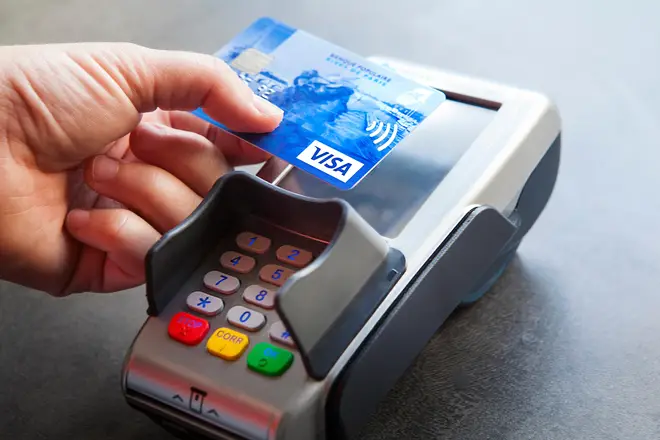
Ali Miraj 12pm - 3pm
15 October 2021, 00:04 | Updated: 15 October 2021, 10:22

Shoppers can now make payments of up to £100 with a single tap of their card as the contactless limit rises by £55.
It has increased from £45, although it could take months for some retailers to update their terminals to allow higher payments, according to the British Retail Consortium (BRC).
"The new £100 limit offers customers greater choice about how they pay for things like their weekly shop or a tank of fuel," said David Postings, chief executive of UK Finance.
"Contactless payments have become increasingly popular, and the payments industry has worked hard to ensure retailers are able to offer customers the new higher limit."
Read more: Eco protesters to suspend blocking roads after drivers fight back
Read more: 'I can't understand it': Sajid Javid blasts Khan's London fireworks cancellation
The decision to raise the contactless limit from £45 to £100 was made by the Treasury and the Financial Conduct Authority (FCA) following a public consultation and discussions with the retail and banking sectors - but the move has raised some concerns about the potential for fraud.
An FCA spokesman said the rules have been changed to help the industry continue "to respond to the changing ways in which people prefer to pay" and said there was "no significant increase in contactless payment-related fraud" since the last increase in April 2020,
He added: "We have seen no material increase in fraudulent transactions in other countries where the contactless limit increased to the equivalent of £100 or above."
He said it was up to firms to monitor for fraud and work to reduce the risk of unauthorised transactions, and that the FCA would watch the data closely to see if the increase caused a rise in fraudulent payments.

IFS boss: public finances could come under pressure if economy shrinks
UK Finance has said people should always contact their bank immediately if their card is lost or stolen or they notice any strange transactions on their account.
Under fraud protection rules, people can claim a refund if someone else makes an unauthorised payment from their account; for example, after their card has been stolen.
Cards also have an in-built security check so that, after a certain amount of contactless spending is undertaken or a certain number of transactions have been made, customers will need to enter their pin number.
Sarah Pennells, consumer finance specialist at Royal London, said the risk of fraud on contactless cards was low but acknowledged it was "distressing" for victims who did experience it.
"You should treat your contactless card the same way as you'd treat cash in your pocket, so be careful when you use it and don't give it to anyone else," said Ms Pennells.
Some banks will allow people to set their own contactless card limits at less than £100, or turn off contactless altogether.
Read more: Supermarkets accused of 'disguising' poorly-stocked shelves amid supply shortage
Read more: London's Night Tube will return next month, Sadiq Khan confirms
Because of the need to update card terminals, the BRC say it could take months for retailers to make the changes and advised customers to check with individual stores.
Andrew Cregan, payments policy adviser at the BRC, said: "While the UK contactless limit rises to £100 on Friday, it may take days, weeks, or even months for some retailers to make the necessary changes in their systems so that the new limit can take effect.
"Furthermore, some retailers may choose not to adopt the new contactless limit. As a result, customers will need to take care when making payments to check what the maximum contactless limit is for individual stores."

Rishi Sunak says being 'responsible with the nation's finances' is 'really important' to him
The increase from Friday marks the fifth time that the limit has been raised, after it was initially set at £10 in 2007.
The limit was increased to £45 in April 2020, early on in the coronavirus pandemic.
Some shops restricted people's ability to pay with cash during the crisis, although Bank of England research suggests the risk of catching Covid-19 from banknotes is low.
Between January and July, 60 per cent of all debit and credit card transactions across the UK were contactless, according to trade association UK Finance.
UK Finance's figures also show that, in 2016, just 7 per cent of all payments, including cash, were made using contactless cards.
By 2018 this had increased to nearly one in five transactions, and by 2020 more than a quarter of all payments were being made using contactless cards.